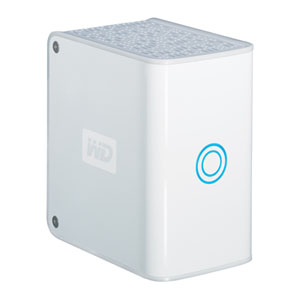Table of Contents
WD MyBook World Edition II
.. is an external storage device produced by Western Digital. You can use this product to: <blockquote>
- Securely access and edit your files on any computer.
- Get files from home while at the office.
- Listen to the music on your My Book World Edition drive while you’re on vacation.
- Securely share photos with your friends anywhere in the world without uploading them to the web.
- Back up your laptop data to your home computer while you’re traveling.
- Offer your clients an easy way to access business documents, designs, and artwork.
- Eliminates the need for a separate FTP server.
- Back up critical files to a remote drive for the ultimate protection from loss.
- Simplify your home network and access data from any computer or external hard drive in the house.
- Automatically back up all your PCs to one central location.
- Gain peace of mind with a mirrored back up of important documents and images.
<cite>Western Digital, Product website</cite> </blockquote>
Product Specifications
| Performance | |
|---|---|
| Ethernet Network | 10/100/1000 Mb/s capable |
| Download | 2Mbps - 9Mbps |
| Upload | 1Mbps - 5Mbps |
| Hard disk storage | |
| Capacities | 2TB 1.5TB 1TB |
| Buffer | 16 MB |
| RPM | 7200 |
| Interface | Ethernet, USB 2.0* |
| Physical Dimensions | |
| Height | 174.61 mm (Max) |
| Length | 159.31 mm (Max) |
| Width | 104 mm |
| Weight | 2.67 kg |
* to add other external hard drive
Similar Products
| Device Name | Hard Disk Capacities | Interface |
|---|---|---|
| My Book – External Storage Devices | ||
| Essential Edition | 1TB 750GB 500GB 320GB 160GB | USB 2.0 |
| Home Edition | 1TB 750GB 500GB 320GB | USB 2.0, eSATA, FireWire 400 |
| Office Edition | 1TB 750GB 500GB 320GB | USB 2.0 |
| Studio Edition | 1TB 750GB 500GB 320GB | USB 2.0, eSATA, FireWire 400/800 |
| Studio Edition II | 2TB 1TB | USB 2.0, eSATA, FireWire 400/800 |
| World Edition | 1TB 750GB 500GB | Ethernet |
| World Edition II | 2TB 1.5TB 1TB | Ethernet |
| Premium Edition II | 2TB 1.5TB 1TB | USB 2.0, FireWire 400/800 |
| My Passport – Portable Hard Drives | ||
| Essential | 320GB 250GB 160GB 120GB | USB 2.0 |
| Elite | 320GB 250GB | USB 2.0 |
| My DVR Expander – External DVR Storage | ||
| My DVR Expander | 500GB | eSATA |
| WD Elements – External Hard Drives | ||
| Desktop | 500GB 400GB 320GB 250GB | USB 2.0 |
| Portable | 250GB 160GB 120GB 80GB | USB 2.0 |
<note warning>The author and the development team do not assume responsability for any harm or loss you may suffer if you execute the fallowing code. The information provided is considered experimental and if you don't know what you are doing you may crash your device for good.</note>
Device Hacks
To install a fully functional Linux web server on a new WD MyBook World all the fallowing steps must be executed in the given order. You may alter this order or the commands provided if you what to customise the server.
- Start SSH server – Access the Admin web interface to enable the SSH support.
- Configure Optware – Install software package repositories support
- Install MySQL – Download, configure and compile the MySQL server
- Install PHP – Download, configure and compile PHP and some important extensions
- Configure Lighttpd – Update Lighttpd configuration files to serve PHP
Tips and Tricks
- Secure Public Folder – Security settings for PUBLIC folder reset with every reboot
- Firmware Update – Important information about the Update Firmware process.
- Performance Optimization – Reduce the memory usage and reduce the fan and drive noises.
- Shell Tips and Tricks – Configure optware, mc, vi, winscp…
